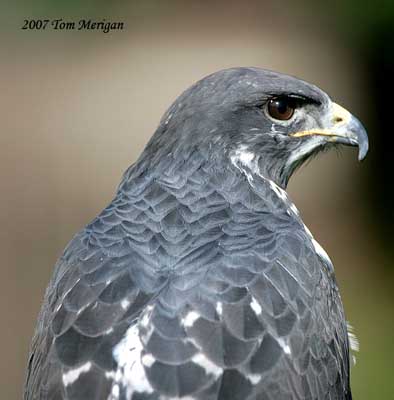Fr: Buse augure
All: Augurbussard
Esp: Busardo Augur Oriental
Ita: Poiana augurale nordafricana
Nd: Augurbuizerd
Sd: Augurvråk
Photographers:
Steve Garvie
RAINBIRDER Photo galleries
Ken Havard
My Bird Gallery & Flickr gallery 1 & Flickr gallery 2
Tom Merigan
Tom Merigan’s Photo Galleries
Text by Nicole Bouglouan
Sources:
HANDBOOK OF THE BIRDS OF THE WORLD Vol 2 by Josep del Hoyo-Andrew Elliot-Jordi Sargatal - Lynx Edicions - ISBN: 8487334156
BIRDS OF PREY OF AFRICA AND ITS ISLANDS by Alan and Meg Kemp - Struik Publishers - ISBN: 1770073698
BIRDS OF EAST AFRICA vol 1 by C.A.W. Guggisberg – Mount Kenya Sundries Ltd. – ISBN: 9966889051
BIRDS OF AFRICA SOUTH OF THE SAHARA by Ian Sinclair and Peter Ryan - Princeton University Press Princeton and Oxford - ISBN: 0691118159
BirdLife International (BirdLife International)
Global Raptor Information Network - Working to Conserve Birds of Prey in nature
Augur Buzzard
Buteo augur
Accipitriformes Order – Accipitridae Family
INTRODUCTION:
The Augur Buzzard is common in open land and cultivated areas, above 1000 metres of elevation. This is a large buzzard with short, rounded tail and broad wings, with very broad secondaries. It is often seen perched in open, on rocks, mounds or trees. This species exhibits two different plumages, with dark and normal morphs.
DESCRIPTION OF THE BIRD:
Biometrics:
Length: 55-60 cm
Wingspan: 132 cm
Weight: 1100-1300 g
The adult has dark grey, almost black upperparts. The flight feathers are black with pale grey bars mainly on secondaries. The tail is rufous with faint dark grey bars.
The underparts are white, including the underwing-coverts, but the carpal patch is black. The flight feathers are white with indistinct black barring and broad black tips.
The head is dark grey. The male shows white chin and throat, whereas the female has dark grey head, chin and throat, the latter with more extensive black markings.
The bill is black with yellow cere. The eyes are reddish-brown. Legs and feet are yellow.
Both sexes are almost similar, but the female is slightly larger than male.
The juvenile is brown above and buffy-white below, with dark streaking on throat and breast. The tail is rufous-brown, narrowly barred darker brown.
The Augur Buzzard in dark morph has black body and underwing-coverts. The flight feathers are white with black barring and broad black tips. The tail is rufous.
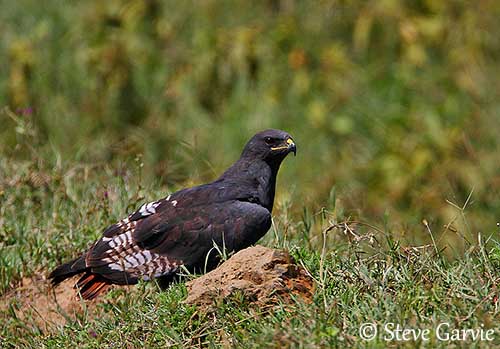
RANGE:
The Augur Buzzard is found in NW Somalia and Ethiopia, S to Zimbabwe, and W to S Angola and N and C Namibia.
HABITAT:
The Augur Buzzard frequents hilly and mountainous country at all elevations, from sea-level to highest peaks. It needs forest patches and open woodlands or exotic plantations for roosting and nesting. It hunts in more open areas such as grasslands and savannas.
The dark morph occurs mainly in moist habitats in the E African part of the range.
CALLS AND SONGS: SOUNDS BY XENO-CANTO
The Augur Buzzard gives harsh “a-kow a-kow a-kow a-kow” during the flight displays. The male’s calls are usually higher-pitched than those of the female.
This species can be noisy outside the breeding season too. It calls with loud yelping notes from perch or in flight. The most frequent calls are ringing, far-carrying “guang-guang”.
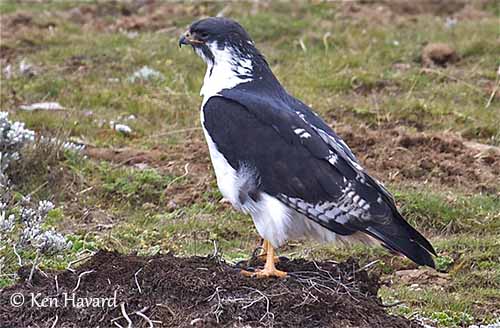
BEHAVIOUR IN THE WILD:
The Augur Buzzard feeds mainly on reptiles (lizards and snakes), rodents and mole-rats, small birds, insects and carrion.
It hunts from perch, rock or tree, where it spends much time while waiting for preys. But it also hunts on the wing by soaring, hovering or gliding. It descends slowly on the prey once detected. It may hunt by walking or hopping on the ground, and is able to perform strong hunting on larger animals such as hares, hyrax and gamebirds.
It hunts in forest or woodland, but also in more open areas.
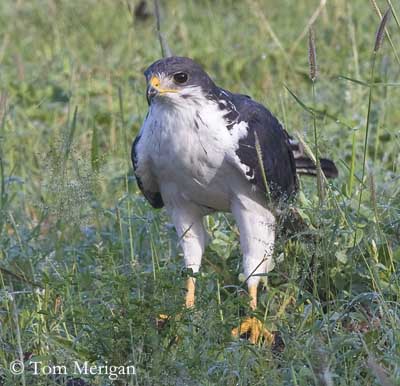
Like in numerous birds of prey, the display flights are spectacular. The aerial displays include several acrobatic postures in flight such as parachuting, stooping and diving. Both mates perform the typical “talon-grappling”, a common display in raptors. This behaviour is accompanied by calls.
During the breeding season, the Augur Buzzard is very territorial and strongly defends its area. The same territory is reused year after year, often during several following years.
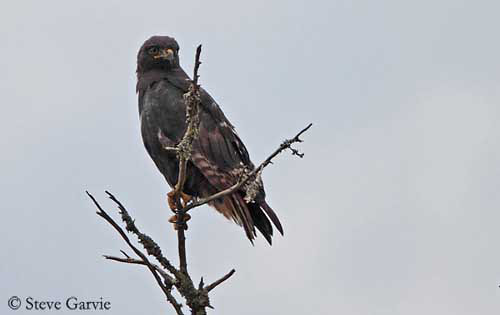
The Augur Buzzard is resident and sedentary in its range. However, the immature birds might be more nomadic than adults, with some movements outside the breeding season.
The flight is agile and fast. The bird soars on raised wings with rocking flight, or hangs in the wind with bent wrists. But it is able to perform fast flight with shallow, stiff wingbeats.
REPRODUCTION OF THIS SPECIES:
The laying period varies depending on the range, but spreads over all months.
The nest is built by both sexes. It can reach a diameter of 100 centimetres. It is placed in tree but not in the crown, and more often on cliff ledge, between 7 and 15 metres above the ground. The nest is typically made with sticks, and lined with green leaves. It is reused in consecutive years, but usually, the pair has two or three alternative nests.
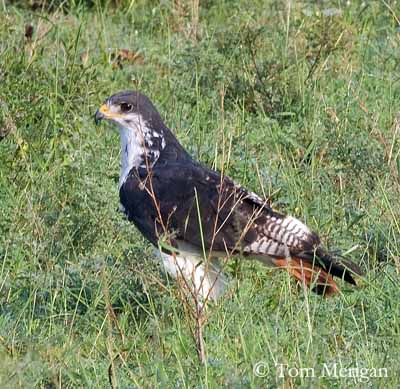
The female lays 1-3 (usually 2) unmarked creamy eggs, or with red-brown or grey-mauve spots and blotches. Both adults share the incubation during 39-40 days, with turns of 1-2 hours. At hatching, the chicks are covered in pale grey down. The female feeds them with food items brought by the male. Usually, only one chick survives, because the elder chick kills the younger sibling. The young fledge between 48 and 60 days after hatching.
PROTECTION / THREATS / STATUS:
The Augur Buzzard is common in its wide range, but the species is affected by deforestation in some areas.
The population is suspected to be stable, and currently, the Augur Buzzard is not threatened.
